- Location
- West Bountiful, UT
With the addition of bumpers, winch, armor etc., and the weight and rolling resistance of 35's, the factory brakes on the LJ have never been more than okay.
I have been running first EBC Yellow Stuff and then later Black Magic pads with Centric premium rotors in the stock configuration. The fancy pads are an improvement, but not exactly amazing. It's been fine for normal driving but panic stops on the interstate have been genuine panic!
The impetus for this project began with driving my wife's new JLUR and noting how awesome the brakes are compared to my LJ. Then, one evening in camp, talking rigs with Carl and Davy, I was complaining about the wimpy little rotors on the LJ and also complaining how expensive big brake kits are.
Carl got to looking around and found this info on a DIY big brake kit http://jeepm62superchargerkit.blogspot.com/p/blog-page.html. And I decided to go for the 17” wheel flavor, utilizing dual piston calipers for an '11-'15 Grand Cherokee or Durango and rotors for an '11-'14 Mustang GT. As described at the source, 1” spacers are needed at assembly to center the caliper on the rotor. More on this later...
So I started sourcing parts, spreading the expense out over two months. The foundation of the project and the first thing I sourced was a pair of steering knuckles from an '84-'89 XJ. These came off an '88.
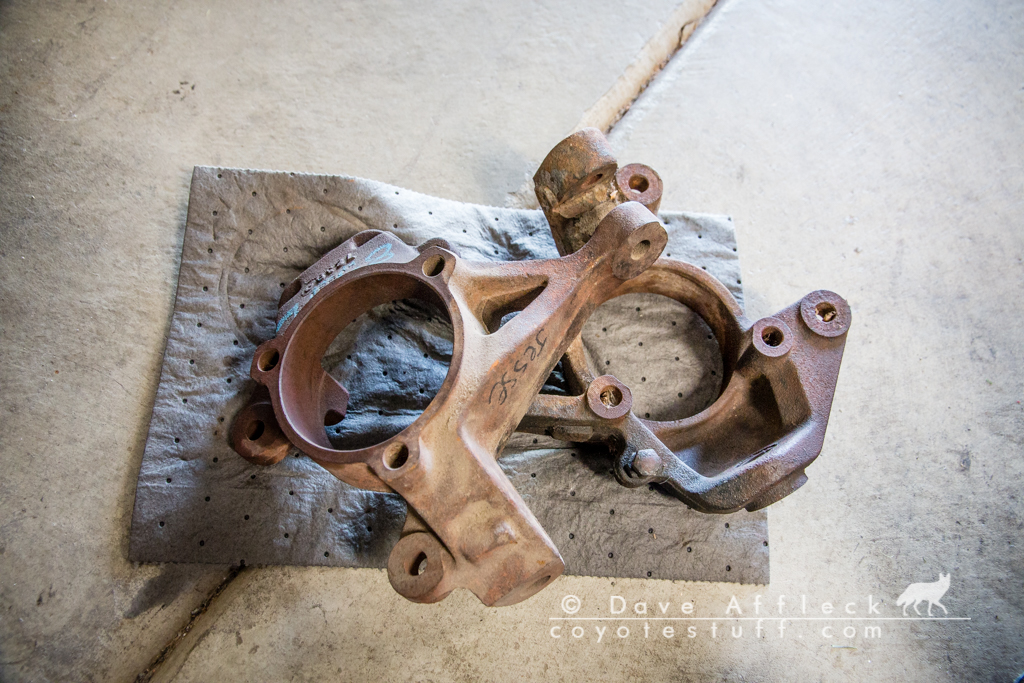
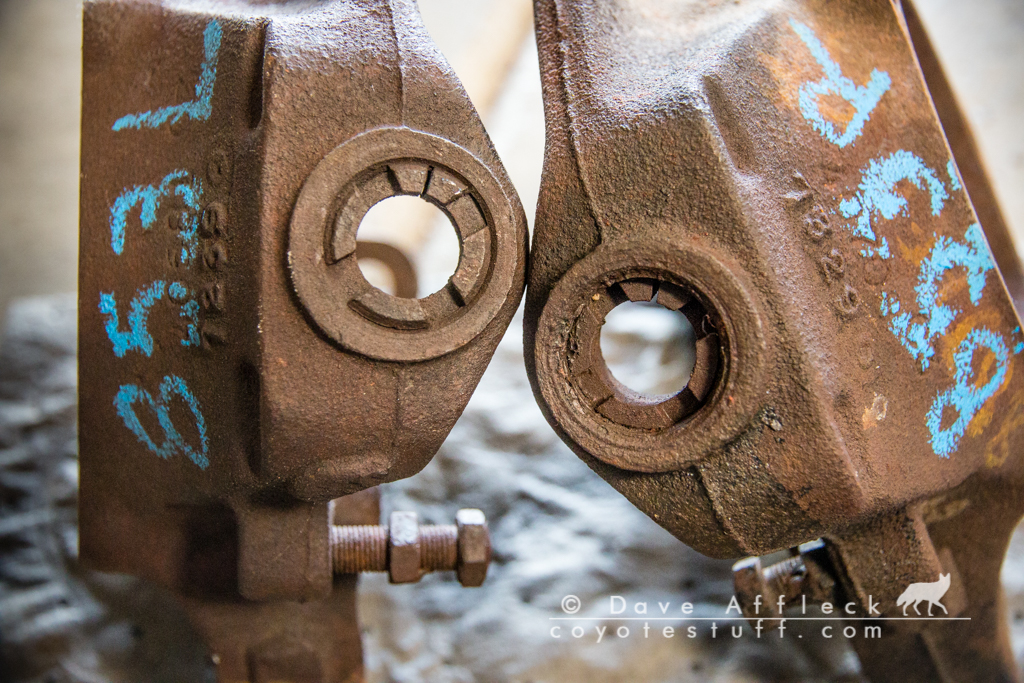
The one on the left has been slightly molested. Both the split ring and steering stop are partially backed out. And it turned out that the threads for that steering stop were jacked up. I had the right 3/8-24 tap in the box already so that was not any big deal though.
I cleaned them up real good, painted them with Eastwood Chassis Black, drilled out the caliper mounting holes to 14mm, installed new split rings to a depth of .206 and cleaned up all the steering stop threads.
The knuckles are ready to go.
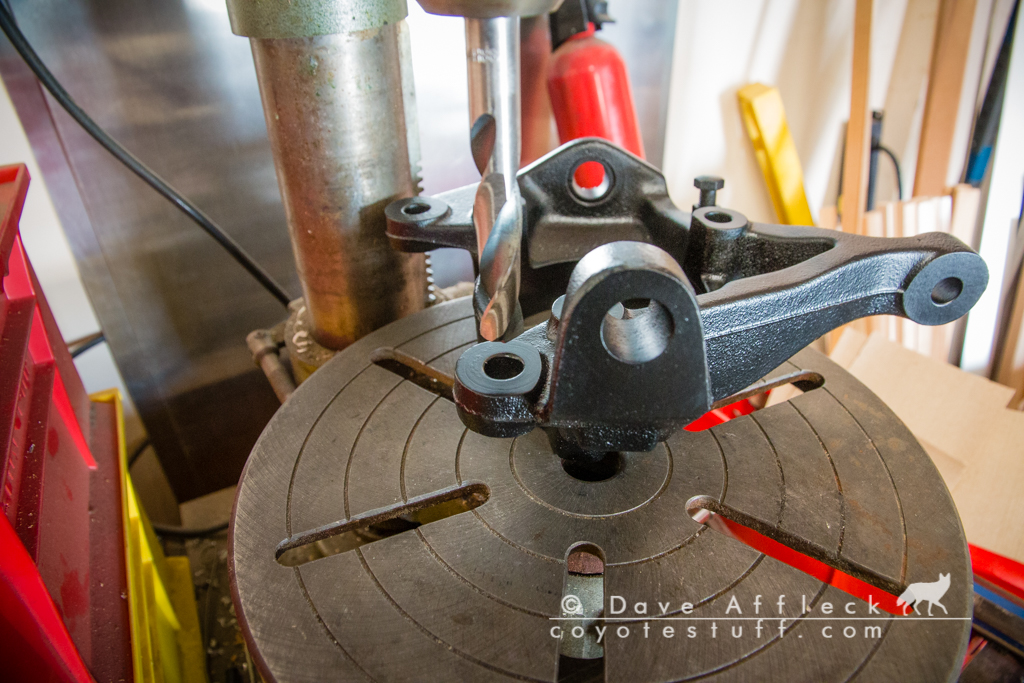
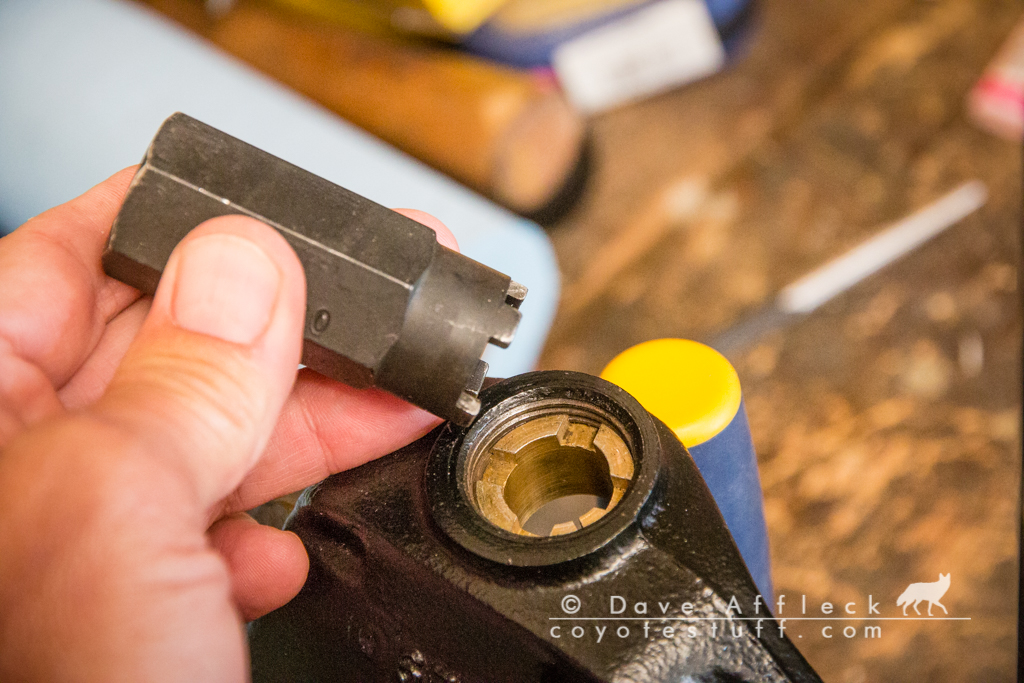

The next item I needed was calipers. I got them off rockauto, dual 48mm piston calipers listed for a 2013 Grand Cherokee. I decided to go fancy and paint them red.
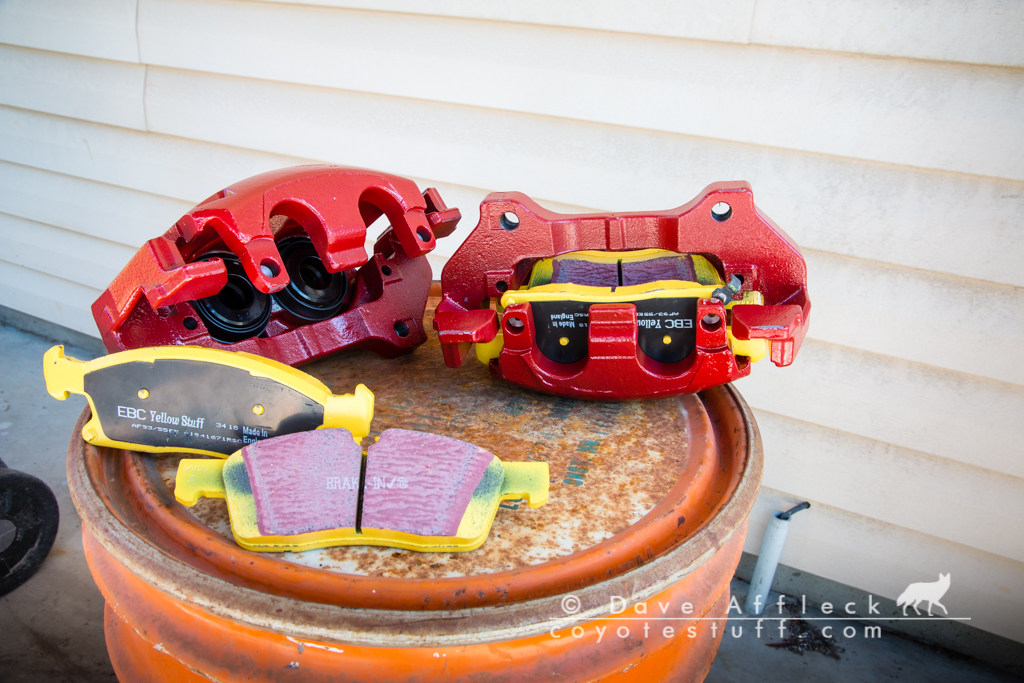
I also decided to spend some money on Yellow Stuff pads. They are expensive as hell, $175. For comparison, during mockup at Carl's I forgot to bring them so I ran to Autozone and got a set of pads there for $27, I'm going to return them . EBC describes them as high dust, highest friction. They are meant for stopping not keeping wheels clean or rotors looking minty, ha-ha! My experience with them is they do deliver a noticeable improvement in stopping power though and just work better when they get hot.
. EBC describes them as high dust, highest friction. They are meant for stopping not keeping wheels clean or rotors looking minty, ha-ha! My experience with them is they do deliver a noticeable improvement in stopping power though and just work better when they get hot.
Next, I ordered all the hardware I thought I'd need. This included 14mm flange bolts long enough for the 1” spacers, new banjo bolts and copper washers and a pair of speed bleeders. Along with a chunk of 1.350 round bar for Carl to make the spacers out of.
A few weeks later when the budget allowed, I was ready to order the last piece needed, the rotors. Carl got to looking again . We both thought the 1” spacers would be okay, but neither of us was in love with that much spacer either. And he brought up that the Grand Cherokee caliper was for a 1.25 thick rotor while the Mustang rotors were 1.18.
. We both thought the 1” spacers would be okay, but neither of us was in love with that much spacer either. And he brought up that the Grand Cherokee caliper was for a 1.25 thick rotor while the Mustang rotors were 1.18.
What he came up with, are rotors for a 2007 Mercedes S550. They are the same 13.25” diameter and a full 1.26” thick. Best of all, the hat height meant they should only need .350” spacers. The center bore would need to be opened up and the lug holes might need to be enlarged as the 4.41” pattern is close but not quite exactly right for the TJ/LJ.
So I ordered a set of Centric rotors for the Mercedes.
As soon as our schedules allowed, I was at Carl's house for the needed rotor modifications and making the spacers. Here is a new rotor after having the center bore opened up on the lathe to 2.840 and the lug holes opened up to 3/4”.

And here are the 1.350x.350 spacers with a 9/16” hole in them that Carl made (after a shot of Chassis Black). By the way, Carl's calculations of spacer thickness based on dimensions in online parts drawings was spot on .
.
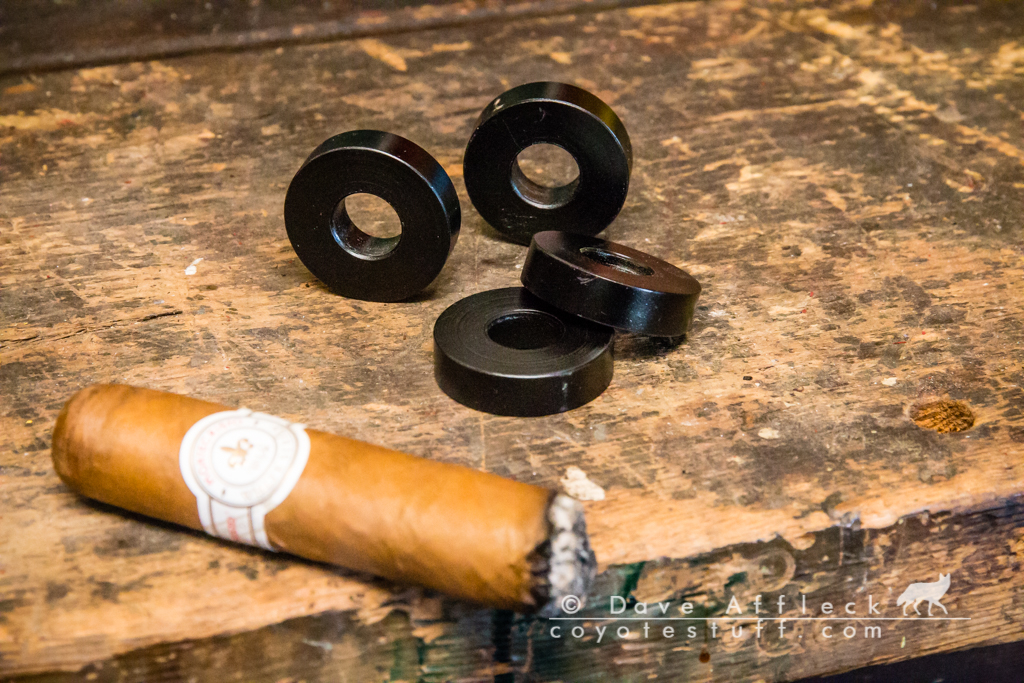

Next minor challenge is that the OD of the unit bearing flange was just slightly too large to fit inside the rotor hat. Just barely wouldn't fit. By taking not much more than enough to make it shiny off the OD of the unit bearing with a flap wheel on a grinder it fit fine. Seriously just barely kissed it, probably didn't take off more than .020. Not nearly enough to remove the factory chamfer.
Here is the final mock up (note the cheap pads are used here).
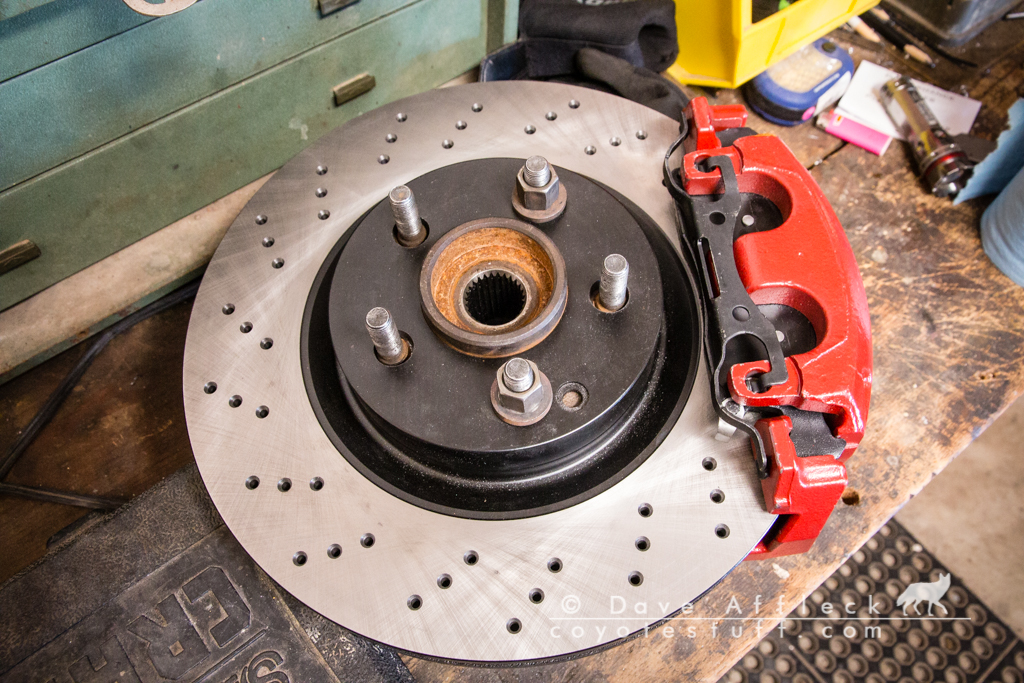
Two minor issues were noted after final mock up. One, the flanged shoulder bolts I had ordered when still intending to use 1” spacers were way too long and worse, the shoulders were too long.
For initial install, I simply trimmed them to the correct length and stacked three washers under the flange to keep the shoulder from bottoming too early. Measurement shows that a 50mm flange bolt would be perfect but I couldn't find any that didn't have the too long shoulder. So I ordered 55mm fully threaded bolts which will be used with one washer to replace the ones that are there now. I just don't like the idea of stacking washers like that.
The other, minor issue noted, was very slight interference between the rotor and caliper.

Very slight rub and only on the outboard circumference of the rotor. Figured it would self clearance quickly, but I decided to make a little more clearance before installation.

That is hardly more than taking the paint off but it was enough to have no contact on the mock up.
And finally, it was time to put it all together! Starting with installing the early XJ knuckles.
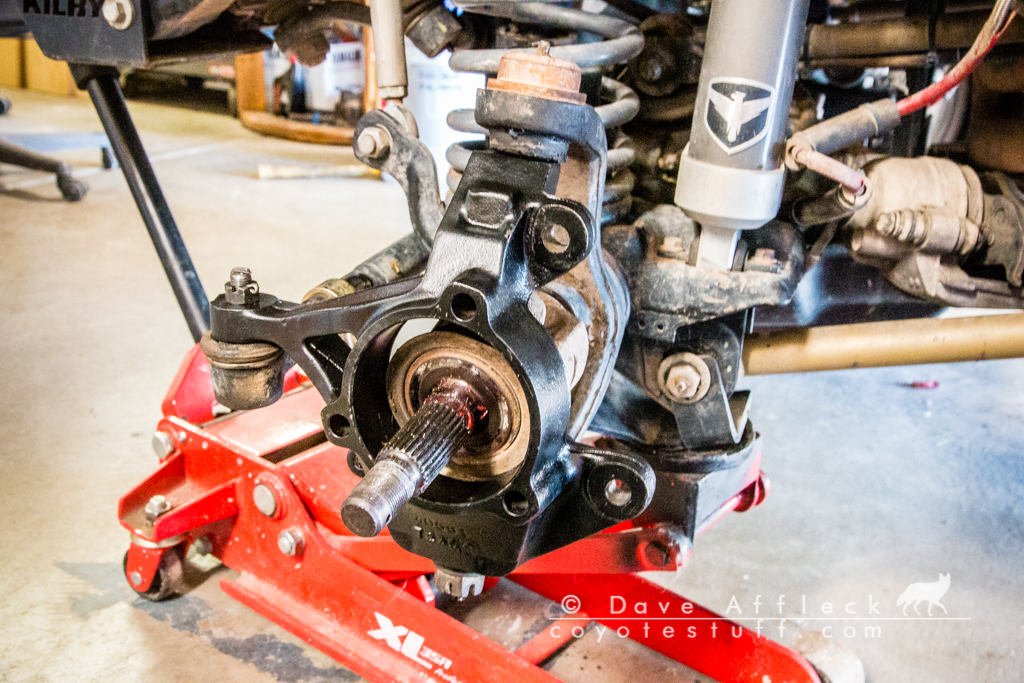
Note the caliper mounting holes, spaced 5.5”, that's the key to making this work. That, along with the XJ knuckle not requiring any other changes, to steering geometry or anything else. Once the installation is ready to begin, it's truly bolt on.
Comparing old rotors to new.
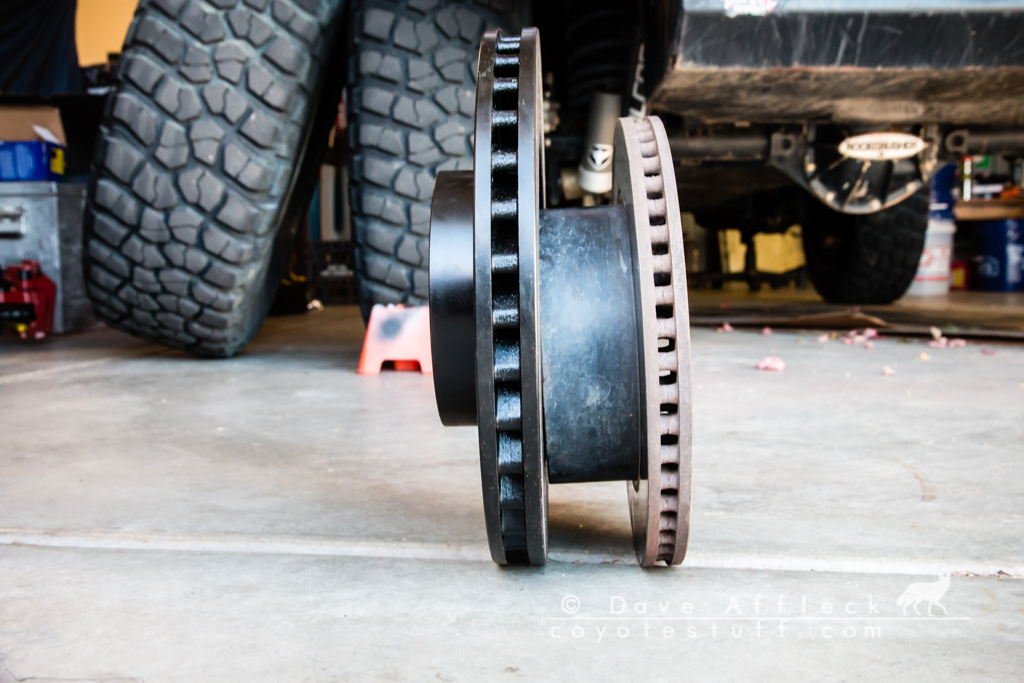
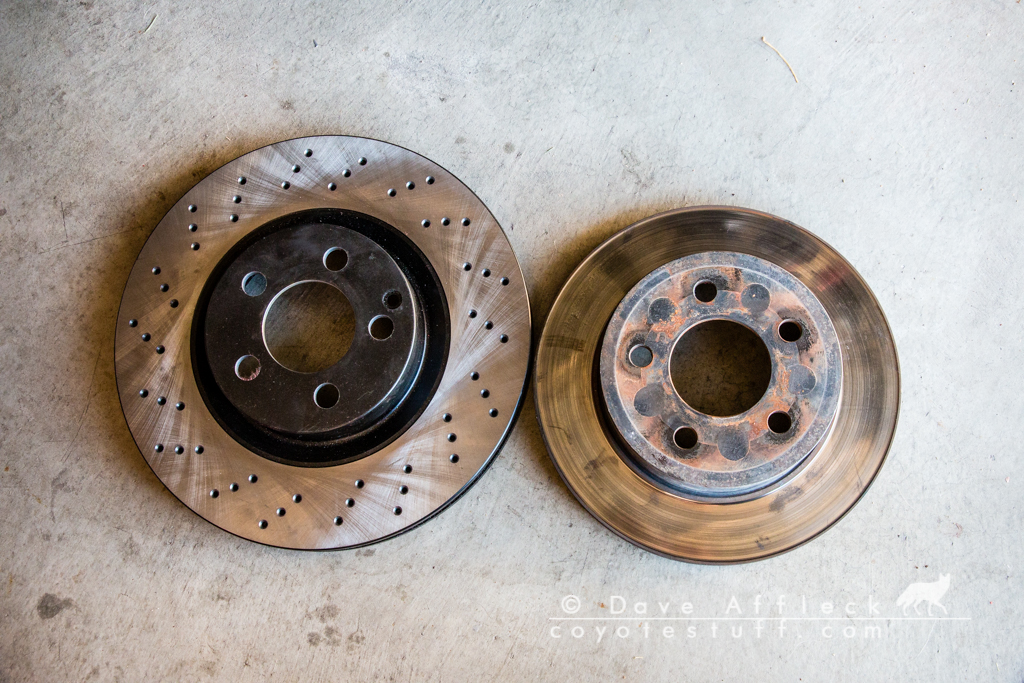
The install didn't go absolutely 100% smooth. I did run into one small problem that I had thought I might. This projection on the calipers had to go in order for the existing banjo fittings on the ends my brake lines to fit.
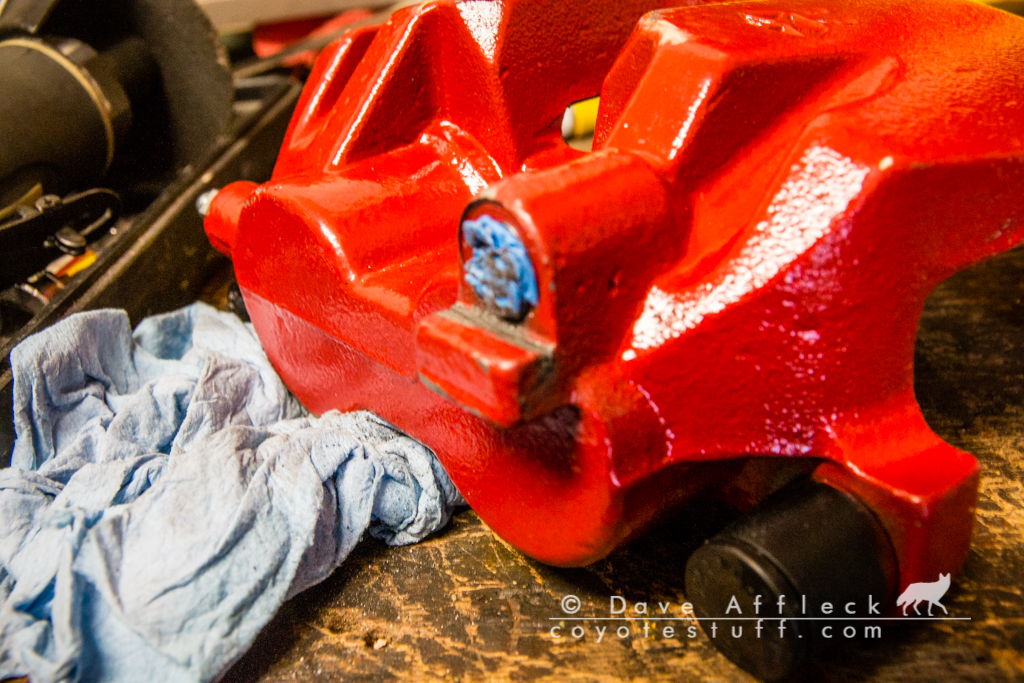
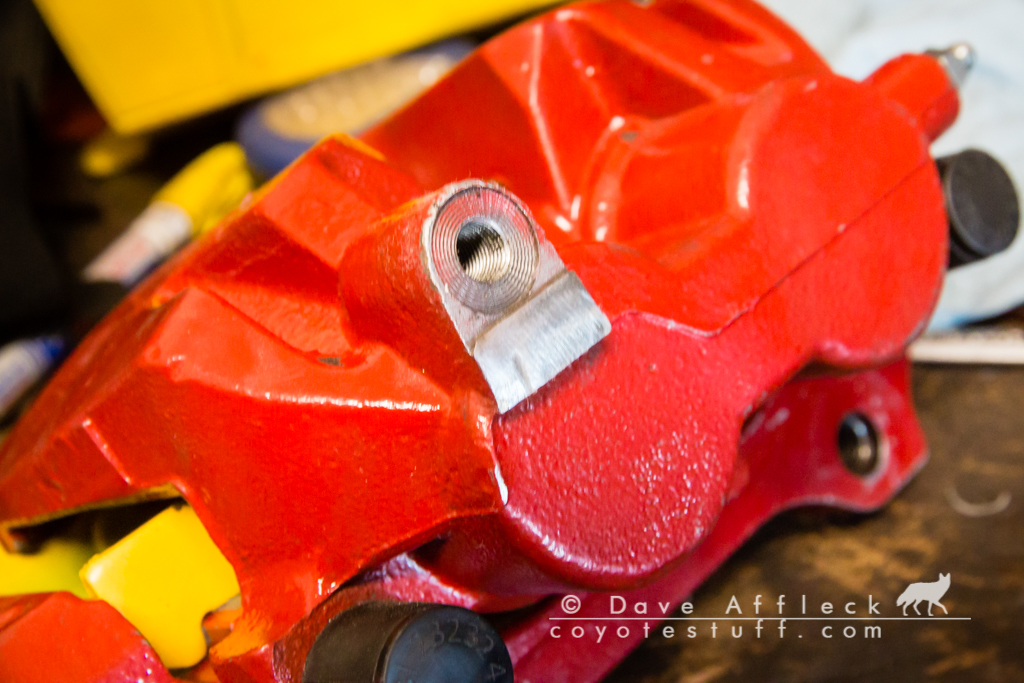
Quick and easy with a cut off wheel. Other than that small bip, install went smooth as silk.
Old brakes/New brakes.

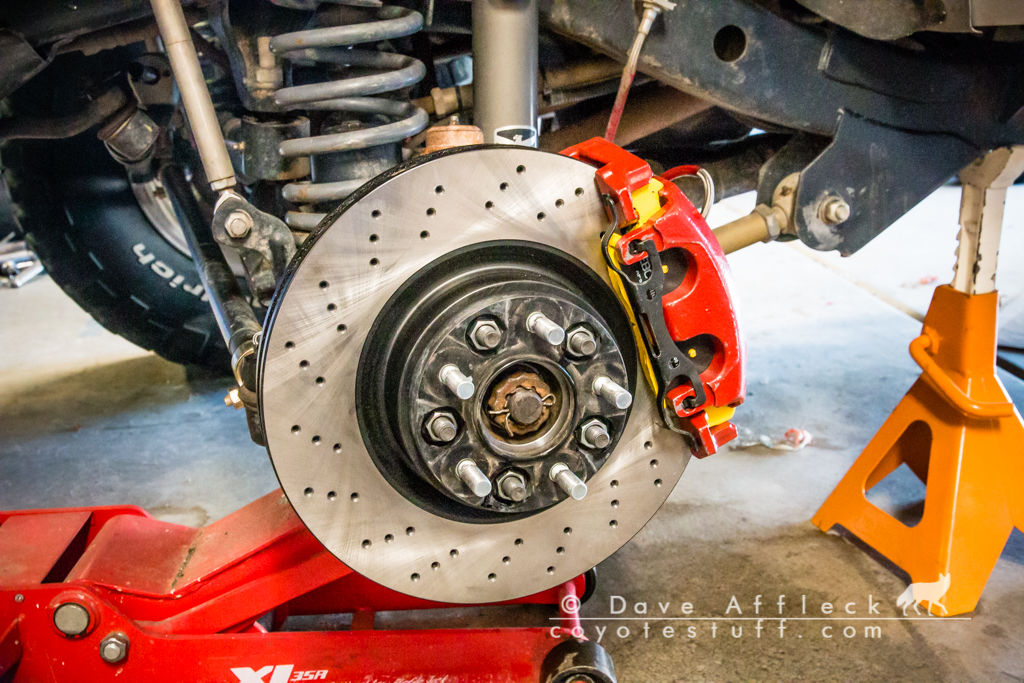
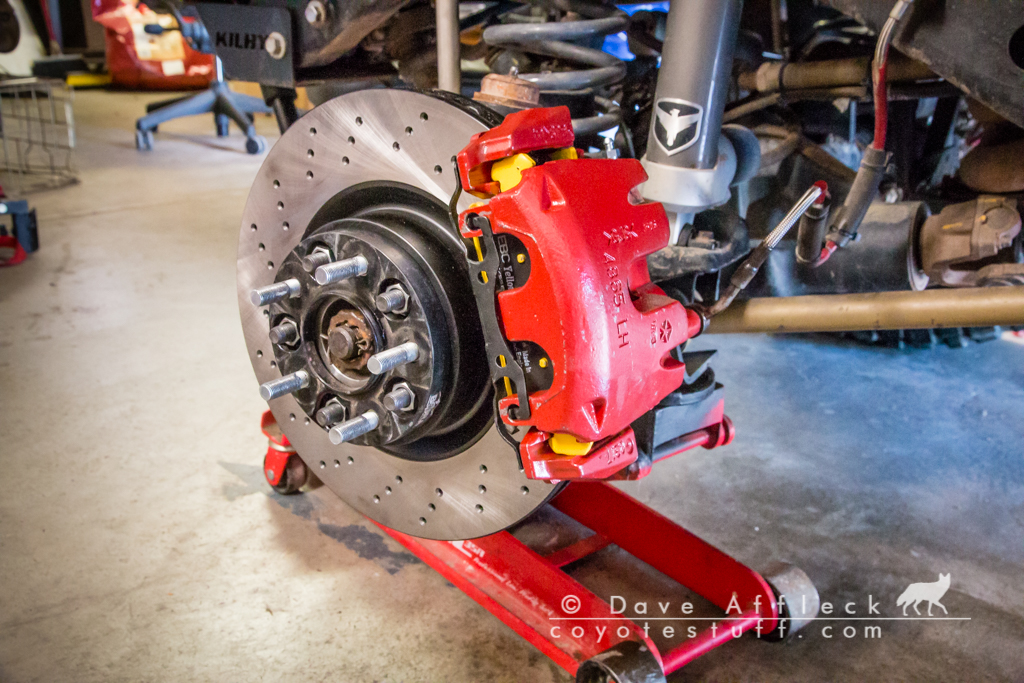
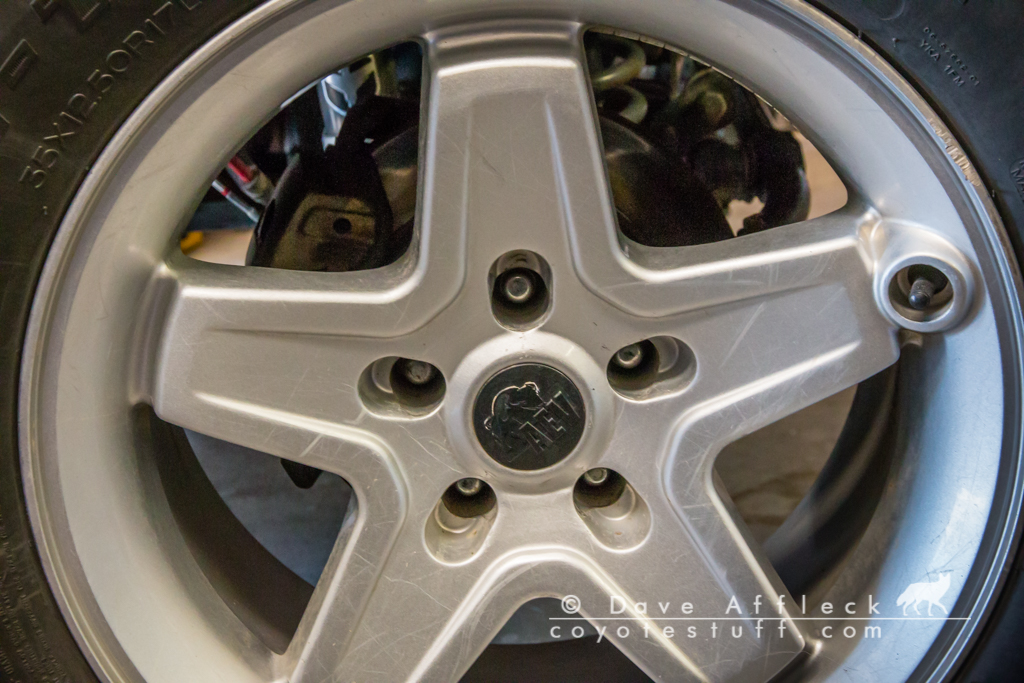
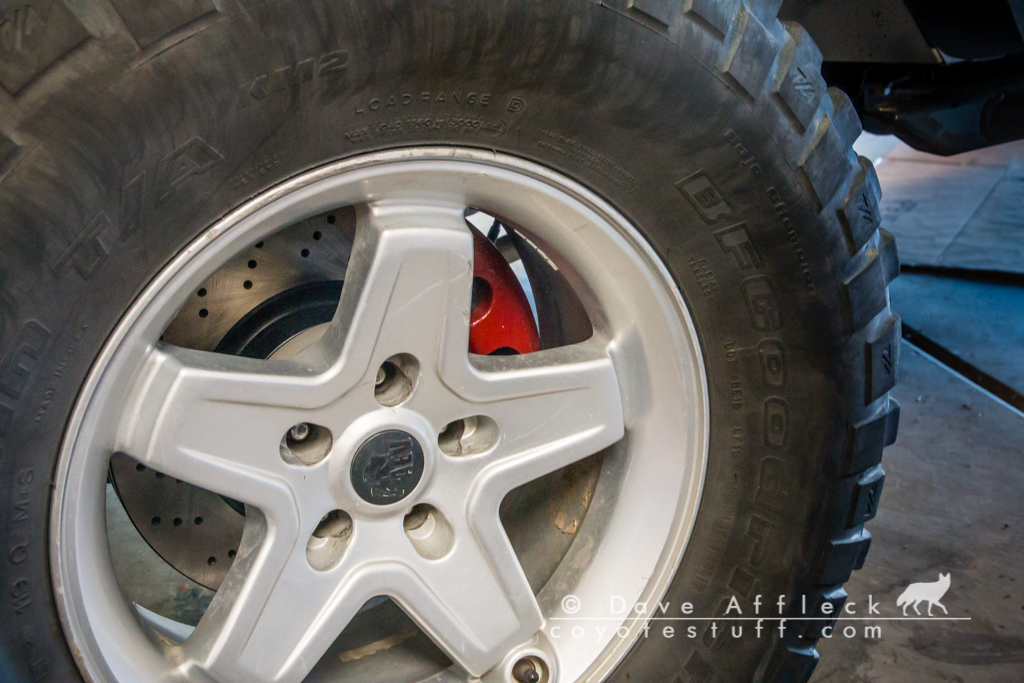
After install, I went for a little test drive and used the pad bedding in procedure outlined by Blaine Johnson here: http://www.blackmagicbrakes.com/instructions.html
I got that procedure from Blaine more than ten years ago when I first switched out the factory configuration to Centric rotors and Yellow stuff pads and I've used it on every brake job since.
For the bedding in you do some back to back moderately hard 40MPH stops without quite actually stopping, then drive without using the brakes to cool them. The second 40 MPH stop, I accidentally locked them up. That, in itself, is amazing! I haven't ever been able to lock them up on pavement going much faster than 25 MPH before.
It was just immediately obvious that the stopping power is just way better. Very noticeable, significant seat of the pants improvement. I was way happy with that first test drive!
But I have some numbers, too. The morning before starting the install, I went out with the old brakes and did some 50MPH to 0 stops on a frontage road. I picked telephone poles to hit the brakes, then after stopping used my Leica laser rangefinder to measure the distance back to the telephone pole.
Average distance for four 50 MPH stops with stock configuration, 120 feet.
The morning after the install and test/bed in drive, I went out again. First, I checked that the caliper bracket bolts with the stacked washers were still tight and they were. I also checked that the banjo bolts were not weeping or dripping and they were dry. Lastly, I decided to bleed them once more, just in case any tiny air bubbles had decided to form and rise to the top of the calipers over night. Based on pedal feel, I may have gotten just a tiny little bit of air out.
So, out to the same frontage road to repeat the test. First one, I didn't count. Because I was so surprised to instantly lock them up at 50 MPH I just came off the brakes and giggled for a few seconds. Can lock them up at will at 50 MPH.
For the four measured stops, I modulated the brakes to not abuse my tires with fully locking up and skidding. I have no doubt a shorter stop could be made in a full blown panic skidding screeching halt. But this is what I came up with, trying not to lock them up.
Average distance for four 50 MPH stops with Better Brakes, 94 feet.
That's well over a 20% improvement, which is damn impressive. They should get better too, as they continue to bed in and wear into the edge chamfers of the pads. And that's with old school manual pedal modulation (no ABS) to avoid flat spotting the tires .
.
Total success!
For something that you use and feel and notice every time you drive to be so improved is awesome. Thanks Carl!
And here are the parts and the cost.
Knuckles – '84-'89 XJ $70
Calipers – 2013 Grand Cherokee 6.4L, Centric 14158011/2, $230
Rotors – 2007 Mercedes S550, Centric 12835099, $130
Pads – EBC Yellow Stuff DP41871R, $175
Bracket bolts – 14x1.5x50, $20
Banjo bolts – Mopar 06508914, $15
Copper washers – Mopar 06502114, $15
Speed bleeders – Dorman 12709 10x1.0.35, $15
Total $670
I went high dollar on the rotors and pads. And you don't have to use speed bleeders (I love them though). You could easily keep this under $500 using less expensive parts. Way cheaper than the big brake kits out there.
- DAA
I have been running first EBC Yellow Stuff and then later Black Magic pads with Centric premium rotors in the stock configuration. The fancy pads are an improvement, but not exactly amazing. It's been fine for normal driving but panic stops on the interstate have been genuine panic!
The impetus for this project began with driving my wife's new JLUR and noting how awesome the brakes are compared to my LJ. Then, one evening in camp, talking rigs with Carl and Davy, I was complaining about the wimpy little rotors on the LJ and also complaining how expensive big brake kits are.
Carl got to looking around and found this info on a DIY big brake kit http://jeepm62superchargerkit.blogspot.com/p/blog-page.html. And I decided to go for the 17” wheel flavor, utilizing dual piston calipers for an '11-'15 Grand Cherokee or Durango and rotors for an '11-'14 Mustang GT. As described at the source, 1” spacers are needed at assembly to center the caliper on the rotor. More on this later...
So I started sourcing parts, spreading the expense out over two months. The foundation of the project and the first thing I sourced was a pair of steering knuckles from an '84-'89 XJ. These came off an '88.
The one on the left has been slightly molested. Both the split ring and steering stop are partially backed out. And it turned out that the threads for that steering stop were jacked up. I had the right 3/8-24 tap in the box already so that was not any big deal though.
I cleaned them up real good, painted them with Eastwood Chassis Black, drilled out the caliper mounting holes to 14mm, installed new split rings to a depth of .206 and cleaned up all the steering stop threads.
The knuckles are ready to go.
The next item I needed was calipers. I got them off rockauto, dual 48mm piston calipers listed for a 2013 Grand Cherokee. I decided to go fancy and paint them red.
I also decided to spend some money on Yellow Stuff pads. They are expensive as hell, $175. For comparison, during mockup at Carl's I forgot to bring them so I ran to Autozone and got a set of pads there for $27, I'm going to return them
Next, I ordered all the hardware I thought I'd need. This included 14mm flange bolts long enough for the 1” spacers, new banjo bolts and copper washers and a pair of speed bleeders. Along with a chunk of 1.350 round bar for Carl to make the spacers out of.
A few weeks later when the budget allowed, I was ready to order the last piece needed, the rotors. Carl got to looking again
What he came up with, are rotors for a 2007 Mercedes S550. They are the same 13.25” diameter and a full 1.26” thick. Best of all, the hat height meant they should only need .350” spacers. The center bore would need to be opened up and the lug holes might need to be enlarged as the 4.41” pattern is close but not quite exactly right for the TJ/LJ.
So I ordered a set of Centric rotors for the Mercedes.
As soon as our schedules allowed, I was at Carl's house for the needed rotor modifications and making the spacers. Here is a new rotor after having the center bore opened up on the lathe to 2.840 and the lug holes opened up to 3/4”.
And here are the 1.350x.350 spacers with a 9/16” hole in them that Carl made (after a shot of Chassis Black). By the way, Carl's calculations of spacer thickness based on dimensions in online parts drawings was spot on
Next minor challenge is that the OD of the unit bearing flange was just slightly too large to fit inside the rotor hat. Just barely wouldn't fit. By taking not much more than enough to make it shiny off the OD of the unit bearing with a flap wheel on a grinder it fit fine. Seriously just barely kissed it, probably didn't take off more than .020. Not nearly enough to remove the factory chamfer.
Here is the final mock up (note the cheap pads are used here).
Two minor issues were noted after final mock up. One, the flanged shoulder bolts I had ordered when still intending to use 1” spacers were way too long and worse, the shoulders were too long.
For initial install, I simply trimmed them to the correct length and stacked three washers under the flange to keep the shoulder from bottoming too early. Measurement shows that a 50mm flange bolt would be perfect but I couldn't find any that didn't have the too long shoulder. So I ordered 55mm fully threaded bolts which will be used with one washer to replace the ones that are there now. I just don't like the idea of stacking washers like that.
The other, minor issue noted, was very slight interference between the rotor and caliper.
Very slight rub and only on the outboard circumference of the rotor. Figured it would self clearance quickly, but I decided to make a little more clearance before installation.
That is hardly more than taking the paint off but it was enough to have no contact on the mock up.
And finally, it was time to put it all together! Starting with installing the early XJ knuckles.
Note the caliper mounting holes, spaced 5.5”, that's the key to making this work. That, along with the XJ knuckle not requiring any other changes, to steering geometry or anything else. Once the installation is ready to begin, it's truly bolt on.
Comparing old rotors to new.
The install didn't go absolutely 100% smooth. I did run into one small problem that I had thought I might. This projection on the calipers had to go in order for the existing banjo fittings on the ends my brake lines to fit.
Quick and easy with a cut off wheel. Other than that small bip, install went smooth as silk.
Old brakes/New brakes.
After install, I went for a little test drive and used the pad bedding in procedure outlined by Blaine Johnson here: http://www.blackmagicbrakes.com/instructions.html
I got that procedure from Blaine more than ten years ago when I first switched out the factory configuration to Centric rotors and Yellow stuff pads and I've used it on every brake job since.
For the bedding in you do some back to back moderately hard 40MPH stops without quite actually stopping, then drive without using the brakes to cool them. The second 40 MPH stop, I accidentally locked them up. That, in itself, is amazing! I haven't ever been able to lock them up on pavement going much faster than 25 MPH before.
It was just immediately obvious that the stopping power is just way better. Very noticeable, significant seat of the pants improvement. I was way happy with that first test drive!
But I have some numbers, too. The morning before starting the install, I went out with the old brakes and did some 50MPH to 0 stops on a frontage road. I picked telephone poles to hit the brakes, then after stopping used my Leica laser rangefinder to measure the distance back to the telephone pole.
Average distance for four 50 MPH stops with stock configuration, 120 feet.
The morning after the install and test/bed in drive, I went out again. First, I checked that the caliper bracket bolts with the stacked washers were still tight and they were. I also checked that the banjo bolts were not weeping or dripping and they were dry. Lastly, I decided to bleed them once more, just in case any tiny air bubbles had decided to form and rise to the top of the calipers over night. Based on pedal feel, I may have gotten just a tiny little bit of air out.
So, out to the same frontage road to repeat the test. First one, I didn't count. Because I was so surprised to instantly lock them up at 50 MPH I just came off the brakes and giggled for a few seconds. Can lock them up at will at 50 MPH.
For the four measured stops, I modulated the brakes to not abuse my tires with fully locking up and skidding. I have no doubt a shorter stop could be made in a full blown panic skidding screeching halt. But this is what I came up with, trying not to lock them up.
Average distance for four 50 MPH stops with Better Brakes, 94 feet.
That's well over a 20% improvement, which is damn impressive. They should get better too, as they continue to bed in and wear into the edge chamfers of the pads. And that's with old school manual pedal modulation (no ABS) to avoid flat spotting the tires
Total success!
For something that you use and feel and notice every time you drive to be so improved is awesome. Thanks Carl!
And here are the parts and the cost.
Knuckles – '84-'89 XJ $70
Calipers – 2013 Grand Cherokee 6.4L, Centric 14158011/2, $230
Rotors – 2007 Mercedes S550, Centric 12835099, $130
Pads – EBC Yellow Stuff DP41871R, $175
Bracket bolts – 14x1.5x50, $20
Banjo bolts – Mopar 06508914, $15
Copper washers – Mopar 06502114, $15
Speed bleeders – Dorman 12709 10x1.0.35, $15
Total $670
I went high dollar on the rotors and pads. And you don't have to use speed bleeders (I love them though). You could easily keep this under $500 using less expensive parts. Way cheaper than the big brake kits out there.
- DAA

